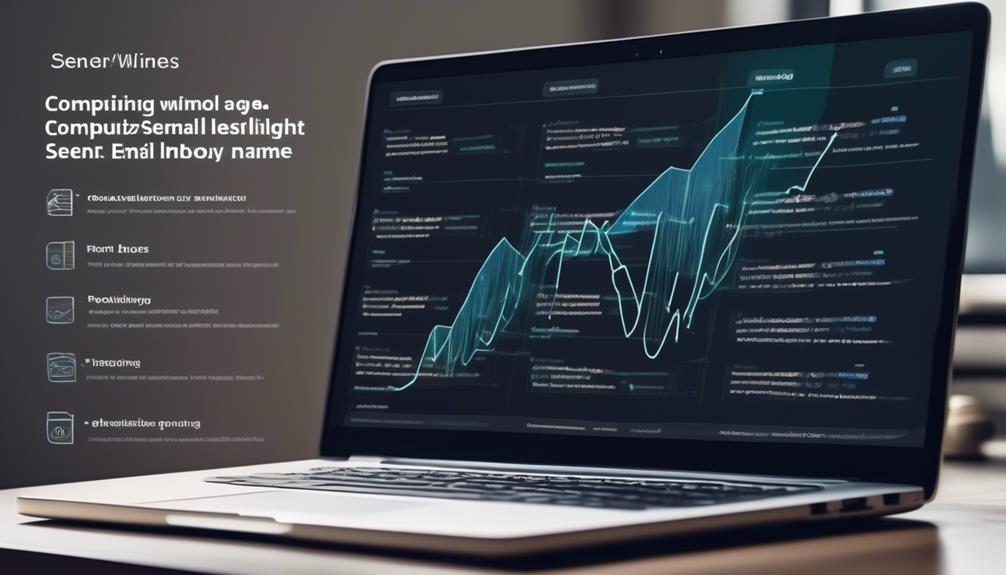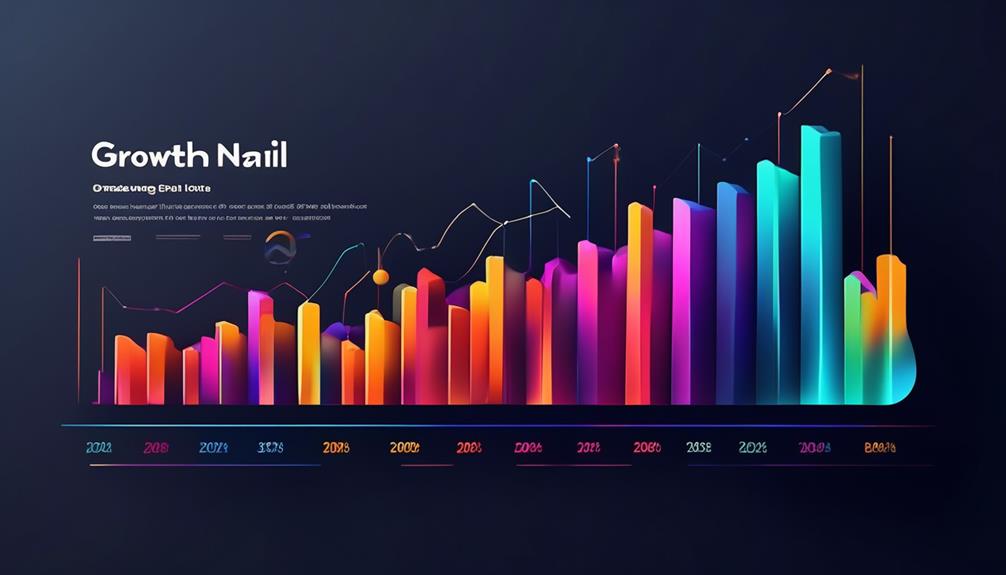In the ever-evolving realm of email marketing, the projected email open rates for 2024 reveal some intriguing insights that may surprise you.
With the constant barrage of emails flooding our inboxes, understanding the factors that influence open rates has never been more critical.
As we navigate through this discussion, we'll explore the trends, industry-specific engagement data, and strategies for maximizing the impact of email campaigns in the coming year.
Join us as we uncover the intricate web of elements that shape email open rates and discover how businesses can leverage this knowledge to enhance their marketing efforts.
Key Takeaways
- The overall average open rate for emails in 2024 is 36.5%.
- Faith-Based Organizations and Nonprofit Membership Organizations show higher engagement rates.
- Technology Services and Transportation Services sectors have lower engagement rates compared to other industries.
- Factors influencing open rates include subject lines, sender reputation, email list quality, timing, and mobile optimization.
Email Open Rate Trends 2024
Analyzing the email open rate trends for 2024 reveals valuable insights into the shifting engagement patterns and opportunities for optimizing email marketing strategies.
The overall average open rate for emails in 2024 stands at 36.5%, with a 1.4% clickthrough rate and 10.4% bounce rate. Understanding these email marketing statistics is crucial for crafting an effective email marketing strategy.
It's important to note that different industries exhibit varying email open and clickthrough rates. For instance, Faith-Based Organizations and Nonprofit Membership Organizations show higher engagement rates, while the Technology Services and Transportation Services sectors have lower engagement rates compared to other industries.
To achieve a good email open rate, it's essential to consider mobile email marketing, as mobile optimization significantly impacts open rates. Furthermore, experimenting with different send times, frequencies, and subject line strategies can help improve email open rates.
Consumer brands and non-profits tend to have higher email open rates, emphasizing the need for tailored email marketing campaigns based on industry benchmarks. Additionally, maintaining low bounce and complaint rates is crucial for better inbox delivery and overall email marketing success.
Factors Influencing Open Rates

The shifting engagement patterns and industry-specific variations in email open rates underscore the critical importance of understanding the factors that influence open rates in email marketing. With the average open rate across industries at 39.7%, subject lines play a crucial role in determining open rates. Clickbaity, irrelevant, vague, or weak subject lines tend to result in lower open rates. Factors influencing open rates also include sender reputation, email list quality, timing and frequency of emails, and mobile optimization.
Furthermore, industry benchmarks for email open rates are crucial to comprehend, as they vary significantly across different industry sectors. For instance, industries such as Faith-Based Organizations and Nonprofit Membership Organizations tend to have higher email engagement rates, while Technology Services and Transportation Services have lower engagement rates. These variations can be influenced by the target audience and the type of emails being sent, such as abandoned cart emails.
To optimize open rates, it's essential for marketers to focus on crafting compelling subject lines, maintaining a strong sender reputation, ensuring high-quality email lists, and strategically timing and optimizing the frequency of their emails.
Email Engagement by Industry
When examining email engagement by industry, it becomes evident that varying open and clickthrough rates present distinct challenges and opportunities for marketers.
The average email open rate across industries stands at 39.7%, with a 1.0% clickthrough rate and 8.4% bounce rate. However, these figures fluctuate significantly across sectors.
For instance, Faith-Based Organizations and Nonprofit Membership Organizations boast higher engagement rates, while Technology Services and Transportation Services experience lower engagement levels. Accoustic's benchmark compilation, representing 750 companies and 3,000 brands in 40 countries, underscores these disparities, with consumer brands and nonprofits exhibiting higher open rates.
Click-to-open rates serve as a crucial metric for gauging engagement with the email content, with 10-15% considered a benchmark. Additionally, monitoring list churn indicators such as hard bounce rates and spam complaint rates is essential. Maintaining low bounce and complaint rates is fundamental for ensuring improved inbox delivery.
Marketers must recognize these variations in email engagement by industry to tailor their email marketing strategies effectively and capitalize on the strengths and opportunities specific to each sector.
Strategies for Maximizing Impact

Maximizing email open rates requires strategic segmentation, personalized content, and automated delivery to enhance engagement and drive measurable impact. By employing targeted strategies, email marketers can significantly improve open rates and clickthrough rates. We can achieve this by crafting compelling subject lines that pique curiosity and provide value to the recipient. Additionally, optimizing content for mobile devices ensures accessibility and readability, thus increasing the likelihood of opens and interactions. Moreover, implementing A/B testing for subject lines and email content allows for data-driven refinement, leading to higher engagement. Furthermore, creating dynamic content tailored to the recipient's preferences and behaviors fosters a sense of personal connection, driving increased open rates and customer loyalty. Lastly, leveraging automation for timely and relevant delivery ensures that emails reach recipients when they are most receptive, thereby maximizing impact. The table below outlines key strategies for maximizing email open rates and driving impactful email marketing campaigns.
| Strategies | Description | Impact |
|---|---|---|
| Strategic Segmentation | Dividing the audience based on demographics, behavior, and preferences for targeted messaging. | Enhanced relevance and engagement. |
| Personalized Content | Tailoring content to individual recipient preferences and behaviors for a personalized experience. | Increased open rates and clickthroughs. |
| Automated Delivery | Utilizing automation for timely and relevant email delivery based on recipient engagement and behavior. | Consistent engagement and improved impact. |
How Do Overall Email Open Rates Compare to Email Open Rates in Specific Industries in 2024?
In 2024, analyzing email open rates industry-wide against specific industries will reveal valuable insights. Understanding how overall email open rates compare to rates in specific industries provides a deeper understanding of consumer engagement. By examining these trends, businesses can tailor their email marketing strategies to meet industry-specific demands and ultimately enhance their overall campaign performance. Stay ahead of the competition by staying informed about email open rates industry 2024.
The Evolving Email Landscape
In the dynamic landscape of email marketing, adaptability and innovation are imperative for maintaining high engagement and impact. The evolving email landscape is heavily influenced by the increasing prevalence of mobile usage, shaping the way recipients interact with email content.
With the majority of users accessing emails through mobile devices, optimizing email content for mobile viewing is crucial. This shift necessitates a strategic approach to email campaign design and content creation to ensure seamless user experiences across various devices.
Furthermore, the evolving landscape presents both challenges and opportunities for digital marketing. Marketers must leverage email statistics to understand open and click rates, allowing for data-driven adjustments to email content and delivery strategies.
As the email landscape continues to evolve, it's essential for marketers to capitalize on emerging marketing opportunities, such as personalized and interactive email campaigns. By staying abreast of the evolving email landscape, marketers can maximize the impact of their email marketing efforts and adapt to the changing preferences and behaviors of their target audience.
Frequently Asked Questions
Is a 20% Email Open Rate Good?
A 20% email open rate is considered good, as it surpasses the average open rate across industries, which stands at 36.5%.
However, it's crucial to note that engagement rates vary across sectors, with some industries having higher benchmarks than others.
Understanding the unique open rates in specific industries is essential for accurate benchmarking and performance evaluation.
Consequently, achieving a 20% open rate could be commendable in certain contexts.
What Is a Typical Open Rate for Emails?
We understand that determining a typical open rate for emails is crucial for optimizing email marketing strategies. Across industries, the average open rate stands at 39.7%, with a 1.0% clickthrough rate and 8.4% bounce rate.
It's essential to note that specific industries may deviate from this average. By analyzing these benchmarks, we can tailor our email campaigns to improve engagement and achieve better results.
Are Email Open Rates Dropping?
Yes, email open rates are dropping.
According to recent data, the average open rate across industries has shown a slight decline. This trend suggests a need for more targeted and personalized email campaigns to maintain engagement levels.
As our team delves into this issue, we aim to identify the specific factors contributing to this decline, allowing us to develop strategies that will help mitigate the drop in open rates.
What Are the Best Open Rate Times for Emails?
We find that the best open rate times for emails tend to align with typical daily routines, such as breakfast time, lunchtime, and early evening. These times often coincide with commutes and the start or end of the workday.
Analyzing open rates also reveals that mid-week days like Tuesday, Wednesday, and Thursday generally yield higher open rates. Additionally, Fridays tend to see slightly higher open rates compared to other weekdays.
-How Can I Improve Email Open Rates for my Small Business in 2024?
Looking to improve your small business’s email open rates in 2024? Consider investing in the best email marketing software available. By utilizing the features and tools offered by the best email marketing software, you can optimize your email campaigns to entice more recipients to open and engage with your messages.
Conclusion
In 2024, the average email open rate is projected to be 18%, showing a slight increase from previous years.
This highlights the importance of optimizing email campaigns to maximize engagement. By focusing on factors like subject lines, sender reputation, and mobile optimization, businesses can improve their open rates and drive the success of their email marketing efforts.
Understanding industry-specific engagement trends and implementing strategic tactics will be key in staying ahead in the evolving email landscape.










